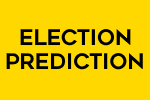








Welcome to election coverage of the Western Australian State election, provided by yours truly at KortJackson.org!
So, How does the Mackerras Pendulum work?
As
most elections in Australia are ran on a Instant Runoff Voting (IRV)
system (also known as a form of Alternative Vote) that results in a
final heads-up result (especially in lower house elections, which
determine control of the government), it is possible to determine what
margin a incumbent can afford to lose before they lose their seat, or
for a challenger to potentially gain a seat.
Noting this, Malcolm Mackerras (an Australian political scientist and psephlogist (one who studies elections)) coined the Mackerras pendulum by listing incumbents and their seats in each party from their weakest (most marginal) seats they are holding to the safest of margins. This pendulum can help demonstrate that if a swing goes from one party to another approximately how many seats may fall to that party. That being said, the pendulum is a guide, it is not a given that if a party earns a five percent swing in their favor, that all seats from their competition will go their way: swings are hardly ever uniform; and sometimes safer seats can surprise and flip suddenly while the most marginal (competitive) of seats refuse to budge.
(c): Crossbench seats are listed in order of most marginal to safest, with each percentage indicating the final 2PP result of which two parties finished as the last two under instant runoff voting and their results
(d): The incumbent sitting in the Electoral District (seat) of Geraldton was elected as a Liberal in the 2017 state election but defected to the WA Nationals. The pendulum reflects the state of the seat as it was decided in 2017.
Noting this, Malcolm Mackerras (an Australian political scientist and psephlogist (one who studies elections)) coined the Mackerras pendulum by listing incumbents and their seats in each party from their weakest (most marginal) seats they are holding to the safest of margins. This pendulum can help demonstrate that if a swing goes from one party to another approximately how many seats may fall to that party. That being said, the pendulum is a guide, it is not a given that if a party earns a five percent swing in their favor, that all seats from their competition will go their way: swings are hardly ever uniform; and sometimes safer seats can surprise and flip suddenly while the most marginal (competitive) of seats refuse to budge.
Below
is the Mackerras Pendulum for the Western Australian Legislative
Assembly. The Government of the day (Labor) is on the left. The
Liberals form the Official opposition and are on the right, followed by
the Crossbench (The Nationals will sometimes work with the Liberals to
form goverment in WA, but unlike their state and federal counterparts,
the WA Nationals often will not join the Liberals in opposition
officially, thus they sit on the Crossbench). Changes and notes
regarding certain seats are noted in smaller text, with details at the
bottom. Seats in italics indicate the incumbent in that seat has opted not to stand for re-election.
(b): The Electoral
District (seat) of Darling Range was won by Labor in the 2017 election,
but the incumbent would later resign due to scandal. A by-election was
held, in which the Liberals regained the seat, and the margin for that
seat reflects the Two-Party Preferred (2PP) result from that election.| Government Seats (Labor, 40) |
Official Opposition Seats (Liberal, 13) |
|||
| Seat Name | Percentage Held | Seat Name | Percentage Held | |
| Joondalup | 0.03% | Hillarys | 0.4% | |
| Kingsley | 1.2% | Dawesville | 0.8% | |
| Murray-Wellington | 1.7% | Darling Range (b) | 3.5% | |
| Jandakot | 1.8% | Riverton | 4.2% | |
| Pilbara | 2.2% | Scarborough | 5.7% | |
| Kalamunda | 2.3% | Kalgoorlie | 6.2% | |
| Bicton | 3.6% | South Perth | 7.2% | |
| Mount Lawley | 4.0% | Bateman | 7.8% | |
| Burns Beach | 5.4% | Nedlands | 8.0% | |
| Albany | 5.9% | Carine | 10.2% | |
| Southern River | 7.9% | Churchlands | 11.7% | |
| Balcatta | 8.0% | Cottesloe | 14.1% | |
| Wanneroo | 8.6% | Vasse | 14.6% | |
| Forrestfield | 9.4% | CROSSBENCH (Nationals, 6) (c) | ||
| Landsdale (a) | 9.6% | Geraldton (d) | 1.3% (LIB vs. ALP) | |
| Bunbury | 10.5% | North West Central | 10.1% (NAT vs. ALP) | |
| Belmont | 11.4% | Warren-Blackwood | 12.8% (NAT vs. ALP) | |
| Swan Hills | 12.1% | Moore | 19.5% (NAT vs. LIB) | |
| Morley | 12.3% | Central Wheatbelt | 22.2% (NAT vs. ALP) | |
| Perth | 12.6% | Roe | 25.9% (NAT vs. LIB) | |
| Midland | 12.8% | |||
| Kimberley | 13.1% | |||
| Cockburn | 14.3% | |||
| Collie Preston | 14.7% | |||
| Thornlie | 15.8% | |||
| Baldivis | 16.6% | |||
| Victoria Park | 16.8% | |||
| Cannington | 17.6% | |||
| Willagee | 17.7% | |||
| Maylands | 17.9% | |||
| Mandurah | 18.0% | |||
| West Swan | 18.4% | |||
| Butler | 20.5% | |||
| Kwinana | 20.7% | |||
| Bassendean | 21.6% | |||
| Fremantle | 23.0% | |||
| Mirrabooka | 23.3% | |||
| Rockingham | 23.5% | |||
| Warnbro | 23.7% | |||
| Armadale | 25.2% | |||
Notes:
Western Australia requires a redistribution (i.e. adjusting boundaries to ensure even populations) prior to every election. Distributions can potentially create seats that notionally go to one party on paper even though another party was holding that seat prior to the redistribution. No seats in the Legislative Assembly were redistributed to this degree, though Joondalup (Labor) and Hillarys (Liberal) were made ultra-marginal, or less than 1.0% to swing the seat.
(a): The Electoral District (seat) of Landsdale was previously called Girrawheen. This was the only name change in the redistribution mandated prior to the election.
Western Australia requires a redistribution (i.e. adjusting boundaries to ensure even populations) prior to every election. Distributions can potentially create seats that notionally go to one party on paper even though another party was holding that seat prior to the redistribution. No seats in the Legislative Assembly were redistributed to this degree, though Joondalup (Labor) and Hillarys (Liberal) were made ultra-marginal, or less than 1.0% to swing the seat.
(a): The Electoral District (seat) of Landsdale was previously called Girrawheen. This was the only name change in the redistribution mandated prior to the election.
(c): Crossbench seats are listed in order of most marginal to safest, with each percentage indicating the final 2PP result of which two parties finished as the last two under instant runoff voting and their results
(d): The incumbent sitting in the Electoral District (seat) of Geraldton was elected as a Liberal in the 2017 state election but defected to the WA Nationals. The pendulum reflects the state of the seat as it was decided in 2017.

Picture of Parliament House, Perth is by nachoman-au and is licensed under a CC BY-SA 3.0 license.